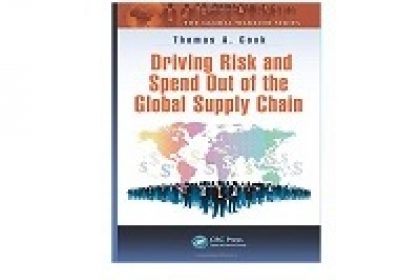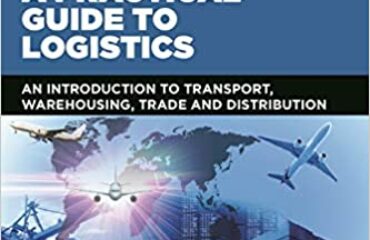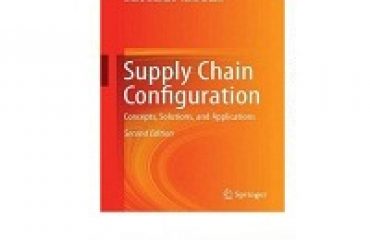
Driving Risk and Spend Out of the Global Supply Chain
Thomas A. Cook
ISBN 9781482226089
Features
- Provides a complete picture of the various risks multinational firms face when operating overseas
- Supplies step-by-step guidance on how to develop an effective global risk strategy
- Presents a blueprint and operational strategy for those charged with reducing risks and costs in their global supply chains
Summary
Driving Risk and Spend Out of the Global Supply Chain provides a complete picture of the various risks multinational firms face when they operate overseas and engage in foreign purchasing and sales, import and export trade, and global logistics. Thomas A. Cook, a subject matter expert on global trade management, supplies readers with step-by-step guidance on how to develop an airtight global risk strategy.
This second book in The Global Warrior Series presents a blueprint and operational strategy for executives to consider when charged with the responsibility of reducing risks and costs in their global supply chains. The book reviews a number of key factors, including:
- The key issues that impact risk and spend in all supply chains
- How to develop effective risk management strategies, tactics, and action plans
- Managing requests for proposal (RFPs) to achieve desired results with minimal compromise
- Risk versus insurance and cargo loss control
- Business model development for a cost reduction program
- Maintaining best practices while reducing risks and costs
- Sarbanes–Oxley issues for public companies
- How to achieve world-class status in international trade
The book examines all the areas where spend can be reduced and details a specific strategy to help readers reduce spend without compromising values. Providing the most comprehensive and up-to-date compilation of material and tactics currently available for international business professionals, the text supplies a clear understanding of the steps readers must take before taking any action to reduce risk and spend in their import, export, and domestic supply chain operations.
Table of Contents
Overview of Risk and Spend Issues in the Global Supply Chain
Overview of Supply Chain Risk
Economic
Political
Contractual and Legal
Relationship, Relationship, Relationship
Local Legal Counsel
Case Study
Hiring Legal Support: Some Helpful Hints
International Contracts: Helpful Hints and Best Practices
Physical (Demographics)
Physical Challenges of Global Trade
Customer, Supplier, and Vendor
Foreign Distributors
You Lose Control over Distribution and Sales Price and Margins
You Cannot Control How They Represent You in the Countries They Are Distributing To or In
Repairs, Service Agreements, and Warranty Handling May Not Be Adequate
Potential Issues with Intellectual Property Rights (IPR)
Reexport Is a Potential Exposure
Resell into the Gray Market Back in the United States or Abroad
Logistics
Leveraging Logistics Options
Reduce Cost with Bonded Warehouses and Foreign Trade Zones
Freight Forwarders and Custom House Brokers Managing Transportation Service Providers
Trade Compliance
Trade Compliance Facilities Reviews
Financial
Financial Risks in Foreign Exchange
How to Export in Foreign Currencies
Best Practices to Reduce Risk
Characteristics of a Foreign Currency–Denominated Export Sale
FX Risk Management Options
Methods of Payment in International Trade
Letters of Credit
Documentary Collections
Open Account
Consignment
Risks
Political Risks
Currency Inconvertibility
Devaluation
Incorrect Utilization of Currency and Exchange Rates
Risk versus Insurance
Characteristics of Export Credit Insurance
Overview of Spend
Managing Landed Costs
Summary
Special Need Supply Chains
Industries with Special Needs
Defense and Export Controlled Products
Failure to Manage the Regulatory Process Proactively
Failure to Train All Personnel in the Global Supply Chain from Sales to Purchasing, Operations and Logistics, Supply Chain, Legal, and Finance
Failure to Create a Compliant and Secure Logistics Supply Chain
Pharmaceuticals
Chain of Custody
FDA Compliance
Communications and Broadcast
Carnets Can Reduce Risk and Cost
Carnet Utilization
Relief Agencies
Food Products
Case Study
Chemicals
Project Business
Clothing and Retail
Developing a Risk Management Strategy
Creating the Necessary Leadership for Risk Management
Assigning Ownership
Building Internal Teams to Tackle Risk Management as a Corporate Responsibility for Everyone
Assessment and Benchmarking
Creating Action Plans
Strategies in Risk Management
Tactics in Risk Management
Summary of Insurance Purchasing for Global Supply Chains
Outline of the Risks in Managing Global Supply Chains
Property
Marine Cargo
Geographic Areas Covered
Named Insured
Modes of Transit Covered
Limits of Liability
Valuation
Underwriting Terms
Special Terms
War, SRCC Coverage
Terrorism
Effective Dates
Storage/Warehousing
Consolidation and Deconsolidation
Domestic Transit
Interruptions in Transit
Exclusions
Loss of Market
Delay
Business Interruption or Consequential Damages
War, SRCC
Inadequate Packing
Cancellation
Liability
Workers’ Compensation
Fiduciary
Key Risk Management Initiatives in Global Trade
Players in Global Supply Chain Risk Management, Brokerage, and Underwriting
Key Initiatives
Disaster Management
Types of Disasters
Disaster Prevention
Disaster Preparedness
Disaster Relief
Disaster Recovery
Global Supply Chain Disaster Management
Mastering Cargo Loss Control
How Do Loss and Damage Occur in International Shipping?
Best Practices: A Company’s Strategy to Combat Loss and Damage in Global Trade
Other Areas That Could Have an Impact on Cargo Outturns
Developing a Cost Reduction Business Model: Creative Leveraging and Aggressive Management Strategies
Change Leadership
Lead by Example
Case Study and Example
The Wrong Way
The Right Way
Utilization of Consultants
Areas in Which Spend and Risk Can Be Dealt with Aggressively
Dealing with Change Management Issues
Moving Theory into Results
World Class, Best Practices, and SOX: While Reducing Risk and Spend
Overview
Typical Global Supply Chain Scenario
Move Freight in a Timely Manner
Move Freight Safely
Move Freight Cost Effectively
Move Freight Securely and Compliantly
Senior Management Leadership
Experienced Management with Global Trade Experience
Utilization of Technology
SWOT Analysis Mindset
Alignment with Quality Service Providers, Advisors, Channel Partners, and Professional Service Organizations
Partner Mentality with Channel Partners
Assessment and Benchmarking
Industry and Trade Organization Participation
International Travel and Relationship Building
Connectivity in the Organization with a Global Supply Chain
Investing in Skill Set Training
Bringing International Culture into the Organization
Leveraging Supply Chain Options—FTZ
Keeping International Travel and Entertainment Costs in Line
Summary
Managing RFPs and RFQs: Maximizing Results
What Are RFPs and RFQs?
Step 1: Define Stakeholders
Step 2: Mine
Step 3: Assess Needs
Step 4: Define Deliverables (Parameters May Be Required)
Step 5: Assign a Committee Approach (Buy-In)
Step 6: Create Basic RFP Outline
Step 7: Identify Potential Partners Who Will Be Invited In to Bid on the RFP
Step 8: Conduct Preliminary Meetings with RFP Participants
Step 9: Establish Metrics or Measurement System for the RFP
Step 10: Send Out Basic RFP Outline—No Pricing Involved
Step 11: Set Dates for Second Meetings with RFP Participants
Step 12: Move Participants List to a Manageable Amount
Step 13: Bring Price into the Equation
Step 14: Move Participants List to One to Three Options
Step 15: Set Full-Blown “Dog and Pony” Show
Step 16: Make Selection, Implementation Strategy, and Follow-Up Evaluation
Implementation Strategy
Review Meetings
The RFP Committee
Spend Issues: Global Operations, Trade Compliance, and Regulatory Management
Trade Compliance Manager
Senior Management Support
Point Person and Committee
Assessment and Benchmarking
SOPs
Technology
Training
Engagement
Import and Export Trade Compliance: Risk and Spend Concerns
Driving Risk and Spend Out of the Global Supply
Chain—Import Perspective
Understanding Incoterms® Rules
Ultimate Consignee
Managing the Import Process
Purchase Order Management
Import Invoices
Import Compliance
Reasonable Care
General Questions for All Transactions
Questions for Merchandise Description and Tariff Classification
Centers of Excellence
Managing the Customs Broker Relationship
Harmonized Tariff Classification
Country of Origin
Marking
Valuation
Importer Security Filing
Drawback
Record Keeping
Driving Risk and Spend Out of the Global Supply Chain—Export Perspective
Incoterms
Export Compliance
Due Diligence
Export Licensing and License Exceptions
Embargoes
Best Practices against Diversion
Foreign Trade Regulations
Restrictive Trade Practices
Examples of Boycott Requests
Export Record Keeping
Managing Freight Forwarders
International Traffic in Arms (ITAR) Regulations
Export Control Reform
Free Trade Agreements
U.S.–Australia Free Trade Agreement
U.S.–Bahrain Free Trade Agreement
CAFTA–DR–U.S.–Peru Free Trade Agreement
U.S.–Chile Free Trade Agreement
U.S.–Colombia Trade Promotion Agreement
U.S.–Israel Free Trade Agreement
U.S.–Jordan Free Trade Agreement
U.S.–Korea Free Trade Agreement (KORUS)
U.S.–Morocco Free Trade Agreement
U.S.–Oman Free Trade Agreement
NAFTA (North American Free Trade Agreement)
U.S.–Panama Trade Promotion Agreement
U.S.–Peru Trade Promotion Agreement
U.S.–Singapore Free Trade Agreement
Export Red Flags
Export Documentation
Effective Compliance Management
Glossary
Resources
Appendix
Index
Author(s) Bio
Thomas A. Cook has been involved in international business and global supply chain management for more than 30 years. He is a graduate of the NYS Merchant Marine Academy with a BS and MS in transportation and business management. He has spent more than six years in the U. S. Naval Reserve and the U. S. Merchant Marines. He founded American River International, a premiere logistics and supply chain management consulting company, in 1982. Last year he stepped down from his position as CEO and managing director and sold his company to existing shareholders.
Cook is a subject matter expert on global trade management, and has published more than 12 books and 300 articles about international business, supply chain management, RFP, negotiation, and world business development. He has sat or currently sits on numerous boards and advisory groups that assist corporations, associations, and industry trade groups in the best practices of running their businesses. He sits or has sat on the board of, or is involved in corporate training with, the following companies: American Management Association (AMA), American Pet Products Association (APPA), Council of Supply Chain Management Professionals (CSCMP), Institute for Supply Management (ISM), and National Association of Purchasing Managers (NAPM), to name a few.
Cook has experience in a number of subjects concerned with general management, including sales, negotiations, customer service, operations, supply chain, logistics, RFP management, business development, and training. He is cofounder of the World Academy, which equips international business executives and operational personnel in supply chain with the skills necessary to operate successfully in global trade.
Currently, Cook is managing director of Blue Tiger International (www.bluetigerintl.com), a management consulting organization focused on international purchasing and RFP enhancements. He is also working on an eight book series entitled The Global Warrior (Taylor & Francis/ CRC Press). Each book gives strategies on the skill sets necessary for the corporate executive of the future to compete in global trade.
Sumber:
https://www.crcpress.com/Driving-Risk-and-Spend-Out-of-the-Global-Supply-Chain/Cook/9781482226089#googlePreviewContainer



